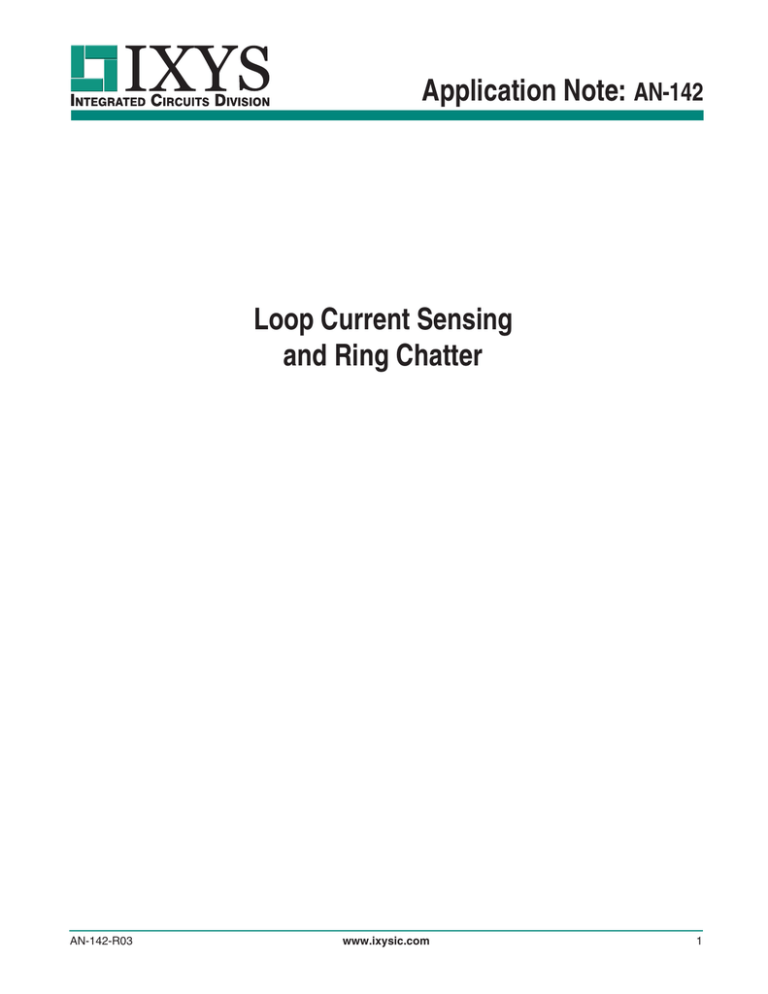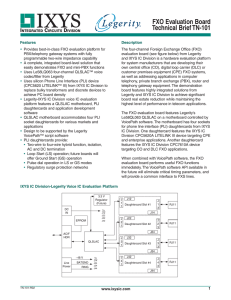
Application Note: AN-142
Loop Current Sensing
and Ring Chatter
AN-142-R03
www.ixysic.com
1
Application Note: AN-142
The M-949 signaling devices sense when a
telephone goes off-hook by monitoring loop current.
Ringing is accomplished by a 20 Hz sine wave with a
nominal amplitude of 86Vrms. The signal is applied
to the ring lead (referenced to tip) so is superimposed on -48 volts. Originating from the Central
Office, ringing voltage often contains harmonics so
peak voltage may not be related to the rms value by
exactly √2. Rapid contact switching or “ring chatter” is
a common result of ringing. Ring chatter occurs when
sufficient ringing current is drawn to operate the loop
current detector. While ring chatter does not harm the
loop sense relay, it can result in false loop current
detects. Since ring chatter is a function of ring current, limiting the ringload avoids the problem. This is
easy to do when monitoring for a ring signal, but
presents a problem when several phones are connected to the line.
activated, C1 discharges to ground through R2 and
D1 is reverse biased. The time count is found from
the following equation:
VDD (e) = VT
where n=-t/rc, and VT is the voltage threshold of the
logic family being used. Assuming a VCC of 5 volts
and VT of 2.5 volts, the above equation can be written as:
t/rc = 0.693
Use this equation to determine r/c values for any
given delay time. The values shown below will provide an approximately symmetrical delay of 16 ms.
Feeding the loop detect output through a comparator
will ensure clean switching action.
The situation can be tackled with a hardware or a
software design solution. A software approach to the
problem would invalidate the loop detect signal while
ringing is detected. The hardware fix consists of
slowing down the response of the loop detect logic
signal. Note that if the application counts rotary dial
pulses, resulting make/break ratios (at Detect Output)
may be somewhat inaccurate. In general, ringer
loads greater than 1 Ringer Equivalence (6.8Ω) will
require larger r/c values. Shown to the right is an
active low “loop Detect” Output. The capacitor is
charged to VCC volts via R1 with D1 included to
bypass R1. Switch S1 represents the loop detect
contacts on the line sensing relay. When the relay is
+5V
R1
10k
LOOP
DETECT
D1
1N4005
R2
12k
C1
2.2µF
S1
M-949
Figure 1 Loop Detect Output Diagram
AN-142-R03
www.ixysic.com
2
Application Note: AN-142
For additional information please visit our website at: www.ixysic.com
IXYS Integrated Circuits Division makes no representations or warranties with respect to the accuracy or completeness of the contents of this publication
and reser
t descriptions at any time without notice. Neither circuit patent licenses nor indemnity
are expressed or implied. Except as set forth in IXYS Integrated Circuits Division’s Standard Terms and Conditions of Sale, IXYS Integrated Circuits Division
assumes no liability whatsoever, and disclaims any express or implied warranty, relating to its products including, but not limited to, the implied warranty
of merchantability
or a particular purpose, or infringement of any intellectual property right.
The products described in this document are not designed, intended, authorized or warranted for use as components in systems intended for surgical
implant into the body, or in other applications intended to support or sustain life, or where malfunction of IXYS Integrated Circuits Division’s product may
result in direct physical harm, injury, or death to a person or severe property or environmental damage. IXYS Integrated Circuits Division reserves the right
to discontinue or make changes to its products at any time without notice.
Specification: AN-142-R03
©Copyright 2014, IXYS Integrated Circuits Division
All rights reserved. Printed in USA.
4/11/2014
AN-142-R03
www.ixysic.com
3


